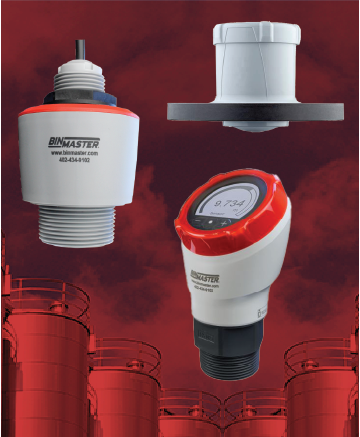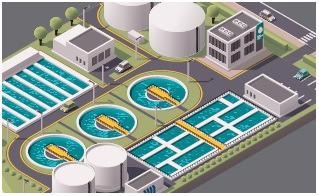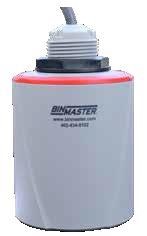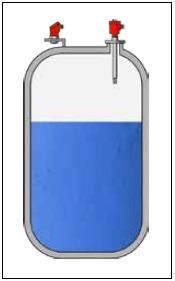80 GHz narrow beam technology is used by the CNCR series of compact non-contact radar level sensors to provide an accurate measurement of simple and aggressive liquids. Using Bluetooth on a phone ensures an easy setup, which can then send level measurement data to a local display, a PLC or a BinCloud® software.

Image Credit: BinMaster
A measuring range of up to 98 feet is offered by these sensors, which install in existing vessel openings or, alternatively, non-intrusively when measuring levels in plastic vessels.
How CNCR Radars Work
A continuous 80 GHz radar signal is transmitted through the face of the antenna by the sensor, which is then reflected off the surface of the material and subsequently received as an echo by the antenna.
The difference in frequency between the received and sent signals is then converted to a measurement which is the distance to the material surface.

Image Credit: BinMaster
Using the vessel height, which is then programmed into the unit when it is set up, the distance is calculated. Setup can then be performed without the requirement to empty the vessel, which saves time. The distance from the face of the antenna to the material surface is recorded as the measurement output, and measurements can be displayed in either inches, feet, or meters.
Bluetooth Facilitates an Easy Setup
A Bluetooth app downloaded to a phone or tablet enables easy setup of CNCR sensors, which can also be done using a Bluetooth USB adapter on a PC.
In addition, changes to bin parameters and viewing of level measurements can be done up to 80 feet from the sensor via the app. This then means the level monitoring and parameter adjustments can be made without climbing tanks.

Image Credit: BinMaster
80 GHz Technology
The CNCR suite of radar level sensors functions as an alternative to the use of pressure transmitters or ultrasonic sensors to measure liquid levels in open-air applications or tanks. These radar level sensors use 80 GHz technology which gives the radar signal a narrow focus in an eight-degree beam angle.
This technology is a reliable method to use in turbulence, condensation and foam. The narrow beam is suitable for use in standpipes or confined vessels and aimed to avoid structures or pipes which have the potential to interfere with the signal.

Image Credit: BinMaster
Extremely high measurement accuracy is delivered by non-contact radar technology (+/-0 .2 inches). These accurate measurements will not be affected in any way by changes in process conditions like fluctuating pressures or temperatures.
Reliable Levels in Liquids
The CNCR series of compact radar level sensors developed by BinMaster is used for non-contact level measurement of a wide range of simple and aggressive liquids of a variety of densities. These sensors are ideally suited to use in both drinking and process water applications along with wastewater applications and a range of water-soluble chemicals.

Image Credit: BinMaster
These continuous level sensors offer reliable measurements in excessive steam, humidity and vapor, and the measurements are unaffected by noise. Thanks to the 80 GHz technology, the sensors perform accurately despite any potential buildup or condensation occurring on the sensor face.
Mounting the CNCR
With the use of a bracket made of stainless steel that extends either 3.25 or 8.0 inches into the vessel. The CNCR can be wall-mounted. The bracket is available with an opening of either 1.0 or 1.5-inches. A stainless-steel bracket which is ceiling-mounted is also available with a 1.5-inch opening.

Image Credit: BinMaster
If aiming is required, customers can choose a 1.5-inch swivel mount created from impact-resistant plastic, which can swivel up to 40° in one direction.
Each of the CNCR sensors, with the exception of the CNCR-190, can also be used in conjunction with a carbon steel, powder-coated 1.5-inch NPT mounting plate in 0°, 5°, 10° and 30° angles. The CNCR-190 has a 1.0-inch flat mounting plate.
Choosing the Right Model
The distance you need to measure and/or the height of the vessel will determine the model best suited to your application, along with whether or not you need a 4-20 mA or Modbus output and indicate how to mount the sensor.

Image Credit: BinMaster
Cabled Sensors - 100 Series
A polyurethane pigtail connection cable is required to install the CNCR-110, 120, 130 and 190 models – the former of which is available in lengths of 16, 32, or 82 feet. These sensors are rated to IP66/IP68 (3 bar) with durable PVDF housings and have excellent chemical, abrasion and flame resistance as well as UV stability.
Long-lasting durability is provided by the FKM seal, thanks to the heat and chemical resistance.
CNCR-190
The 190 model is ideally suited for use in measuring non-contact liquid levels at distances up to 98 feet in applications that are unclassified and where a high level of protection from the environment and elements is needed.

IImage Credit: BinMaster
It is available with either a two-wire 4-20 mA or fourwire Modbus output, as well as featuring a 1.0-inch threaded or straight NPT connection.
The top of the sensor features the cable outlet. For unclassified areas, the 190 has general-purpose FM/CSA/CE approvals or are offered with optional ATEX/ICEx zone 1, 1/2 or FM/CSA/ATEX/ICEx Class I, II, III approvals.
CNCR-120 and CNCR-130
Ideally suited for non-contact liquid level measurement at distances up to 49 feet in applications requiring a high level of environmental protection, the 120 and 130 sensors are offered with either a two-wire 4-20 mA or four-wire Modbus output and the option of a 1.5-inch threaded or a straight NPT connection.

Image Credit: BinMaster
Unlike the 120 model, which has the cable outlet on the top (for mounting on the top of the vessel), the 130 model features the cable outlet on the side.
The 120 and 130 both have approvals of general-purpose FM/CSA/CE level for unclassified areas or are available with optional ATEX/ICEx zone 1, 1/2 or FM/CSA/ATEX/ICEx Class I, II, III approvals.
CNCR-110
The ideal sensor for non-contact liquid level measurement, the 110 sensor, can operate at distances up to 26 feet in applications, which require a significant level of environmental protection.

Image Credit: BinMaster
The CNCR-110 features a two-wire 4-20 mA output and is available for use with either a 1.5-inch threaded connection or straight NPT connection.
The cable outlet is located on the sensor’s top, and the CNCR-110 model is perfect for use in unclassified areas as well as non-EX environments along with general-purpose FM/CSA/CE certifications.
CNCR 100 Series Specifications
Table 1. Source: BinMaster
| |
 |
 |
 |
 |
| MODE OF OPERATION |
| Measuring Principle |
Radar |
Radar |
Radar |
Radar |
| Measuring Range |
26 ft. (8 M) |
49 ft. (15 M) |
49 ft. (15 M) |
98 ft. (30 M) |
| Frequency |
80 GHz |
80 GHz |
80 GHz |
80 GHz |
| Beam Angle |
8° |
8° |
8° |
4° |
| Dead Zone |
None |
None |
None |
None |
| Accuracy |
≤ 0.2” (5 mm) |
≤ .08” (2 mm) |
≤ .08” (2 mm) |
≤ .08” (2 mm) |
| Voltage |
12 to 35 |
VDC 12 to 35 VDC, 8-30 VDC |
12 to 35 VDC, 8-30 VDC |
12 to 35 VDC, 8-30 VDC |
| Output |
2-wire 4-20 mA |
2-wire 4-20 mA,
4-wire Modbus |
2-wire 4-20 mA,
4-wire Modbus |
2-wire 4-20 mA,
4-wire Modbus |
| Enclosure Material |
PVDF |
PVDF |
PVDF |
PVDF |
| Seal Material |
FKM |
FKM |
FKM |
FKM |
| Enclosure Rating |
IP66/IP68 (3 bar) |
IP66/IP68 (3 bar) |
IP66/IP68 (3 bar) |
IP66/IP68 (3 bar) |
| Mounting |
1.5” Threaded NPT,
1.5” Threaded
Straight |
1.5” Threaded NPT,
1.5” Threaded
Straight |
1.5” Threaded NPT,
1.5” Threaded
Straight |
1.0” Threaded NPT,
1.0” Threaded
Straight |
| Connection |
16 ft. (5 m), 32 ft.
(10 m), 82 ft. (25 m) |
16 ft. (5 m), 32 ft.
(10 m), 82 ft. (25 m) |
16 ft. (5 m), 32 ft.
(10 m), 82 ft. (25 m) |
16 ft. (5 m), 32 ft.
(10 m), 82 ft. (25 m) |
| OPERATING CONDITIONS |
| Process Pressure |
-14.5 to +43.51 psi
(-1 to +3 bar/-100 to +300 kPa) |
-14.5 to +43.51 psi
(-1 to +3 bar/-100 to +300 kPa) |
-14.5 to +43.51 psi
(-1 to +3 bar/-100 to +300 kPa) |
-14.5 to +43.51 psi
(-1 to +3 bar/-100 to +300 kPa) |
| Process Temperature |
-40° to +140°F
(-40° to +60°C) |
-40° to +176°F
(-40° to +80°C) |
-40° to +176°F
(-40° to +80°C) |
-40° to +176°F
(-40° to +80°C) |
| Ambient Temperature |
-40° to +140°F
(-40° to +60°C) |
-40° to +176°F
(-40° to +80°C) |
-40° to +176°F
(-40° to +80°C) |
-40° to +176°F
(-40° to +80°C) |
| Approvals |
Unclassified area, non-EX environment, general purpose
FM/CSA/CE |
Unclassified area, non-EX environment, general purpose
FM/CSA/CE; FM/CSA/ATEX/ICEx Class I, II, III; ATEX/ ICEx Zone 1, 1/2 |
Unclassified area, non-EX environment, general purpose
FM/CSA/CE; FM/CSA/ATEX/ICEx Class I, II, III; ATEX/ICEx Zone 1, 1/2 |
Unclassified area, non-EX environment, general purpose
FM/CSA/CE; FM/CSA/ATEX/ICEx Class I, II, III; ATEX/ICEx Zone 1, 1/2 |
Threaded NPT Models - 200 Series
The 210, 220 and 230 models all mount using a 1.5” threaded NPT connection or 1.5” threaded straight NPT connection; their enclosures are rated IP66/IP67, Type 4X in order to act as protection from both water damage and dust.
As a result of these features, the 200 Series act as perfect sensors for taking non-contact level measurement in simple liquid level applications.
These models are also ideal for use in storage tanks with acids, lye, water treatment and additives in all industrial areas, in addition to taking measurements of levels in plastic tanks or IBC containers through the tank walls.
CNCR-230
An LED display on the sensor housing is offered on the 230, which makes level readings accessible from the sensor. Additionally, the sensor can therefore be used to take measurements at a range of up to 49 feet.

Image Credit: BinMaster
The sensor offers a two-wire 4-20 mA output and is available with either a straight NPT connection or a 1.5-inch threaded. The sensor can be used to measure liquid levels through the tank wall when being used on an IBC container or a plastic storage tank.
CNCR-220
Otherwise, much like the 210, the 220 offers an extended measuring range of up to 49 feet. The 220 features a two-wire 4-20 mA output and is available with either a 1.5-inch threaded or a straight NPT connection.
The 220 can also be used for measuring liquid levels through the tank wall when using on a plastic storage tank or an IBC container.

Image Credit: BinMaster
CNCR-210
A continuous liquid level sensor, the compact 210 boasts a measuring range up to 26 feet with a two-wire 4-20 mA output and is available with either a straight NPT connection or a 1.5-inch threaded connection.
As with the 220, the 210 can be used for measuring liquid levels through the tank wall when being used on a plastic storage tank or an IBC container.
CNCR 200 Series Specifications
Table 2. Source: BinMaster
| |
 |
 |
 |
| MODE OF OPERATION |
| Measuring Principle |
Radar |
Radar |
Radar |
| Measuring Range |
26 ft. (8 M) |
49 ft. (15 M) |
49 ft. (15 M) |
| Frequency |
80 GHz |
80 GHz |
80 GHz |
| Beam Angle |
8° |
8° |
8° |
| Dead Zone |
None |
None |
None |
| Accuracy |
≤ 0.2” (5 mm) |
≤ 0.2” (5 mm) |
≤ 0.2” (5 mm) |
| Voltage |
12 to 35 VDC |
12 to 35 VDC |
12 to 35 VDC |
| Output |
2-wire 4-20 mA |
2-wire 4-20 mA |
2-wire 4-20 mA |
| Enclosure Material |
PVDF |
PVDF |
PVDF |
| Seal Material |
FKM |
FKM |
FKM |
| Enclosure Rating |
IP66/IP67, Type 4X |
IP66/IP67, Type 4X |
IP66/IP67, Type 4X |
| Display |
None |
None |
LED Display |
| Mounting |
1.5” Threaded NPT,
1.5” Threaded Straight |
1.5” Threaded NPT,
1.5” Threaded Straight |
1.5” Threaded NPT,
1.5” Threaded Straight |
| Connection |
One 1/2” NPT without plug in either opening |
One 1/2” NPT without plug in either opening |
One 1/2” NPT without plug in either opening |
| OPERATING CONDITONS |
| Process Pressure |
-14.5 to +43.51 psi
(-1 to +3 bar/-100 to +300 kPa) |
-14.5 to +43.51 psi
(-1 to +3 bar/-100 to +300 kPa) |
-14.5 to +43.51 psi
(-1 to +3 bar/-100 to +300 kPa) |
| Process Temperature |
-40° to +140°F (-40° to +60°C) |
-40° to +176°F (-40° to +80°C) |
-40° to +176°F (-40° to +80°C) |
| Ambient Temperature |
-40° to +140°F (-40° to +60°C) |
-40° to +158°F (-40° to +70°C) |
-40° to +158°F (-40° to +70°C) |
| Approvals |
Unclassified area, non-EX environment, general purpose FM/CSA/CE |
Unclassified area, non-EX environment, general purpose FM/CSA/CE |
Unclassified area, non-EX environment, general purpose FM/CSA/CE |
CNCR Applications
Food for Animals and Humans
Food ingredients: Liquid ingredients can present in a multitude of forms which include: sugars, extracts, along with oils that can either be translucent, transparent or opaque.
Beverages: Manufacturers of beverages use juices, water, colorants and additives in the production process, including that of beer, energy drinks, soft drinks or seltzers.

Image Credit: BinMaster
Animal fat: Animal fat is used in the production of lubricants, soap and fatty acids, as well as being a primary ingredient at feed mills used for feedstuffs for pet foods and livestock.
Milk and dairy products: Raw milk storage, pasteurization tanks and processing.
Oil and fat processing: Animal fats and oilseed processing are used for margarine and shortening production along with corn, canola, sunflower and other oils for human consumption.
Egg processing: Processes of chilling, cleaning, pasteurizing and liquid egg processing, all use tanks for storing water.
Liquid food processing: Chocolates, sauces and condiments measured as raw ingredients as well as finished products in storage tanks.

Image Credit: BinMaster
Drinking or Purified Water
Springwater containment: Drinking water from springs is monitored to ensure sufficient supply.
Purified water tanks: Tanks that store purified water at facilities to ensure efficient plant operations and supply for periods of peak demand.

Image Credit: BinMaster
Industrial
Process water: By monitoring the levels in open basins or storage tanks, pressure pumps are able to deliver a continuous supply of process water.
Bulk industrial containers: Measuring levels in drums, IBCs, or totes, installing a lid sensor or measuring or opening through a plastic wall.
Industrial fluids: This is used in the production of coolants, solvents, detergents, lubricants, hydraulic fluid, cleaners, degreasers, defoamers, brighteners, metalworking fluids, cutting oils, inhibitors and rust and scale removers.
Industrial manufacturing: Cooling towers, RO Storage, process and day tanks and waste sumps.
Wastewater: Lift stations, storage tanks, neutralization tanks and open channels.
Cement additives: Measure tanks containing retarders, accelerators, dispersants, extenders and other characteristic control agents which are used to modify cement slurries’ properties.
Plasticizer tanks: Take measurements of liquid resins like polyurethanes, epoxies, polyester and silicones or other types of liquid resins.
Frac or silica sand: Monitoring process water tanks, fracture fluids and flocculants used in sedimentation ponds, dredge pump mining methods and wastewater used for washing and processing.
Water-cooled chillers: By monitoring the level in holding tanks, a continual water supply is ensured in industrial and batch water-cooled chillers.

Image Credit: BinMaster
Oil & Fuels
Automotive oil and fluids: Levels of new and waste fluids are monitored, such as radiator, oil, radiator, power steering, transmission, brake and washer fluids, and air conditioning coolant.
Diesel storage: Transfer tanks, bulk and on-site fuel storage.
Fuel tanks: Provision of an accurate measurement of oils and fuels ensure that an adequate supply is on hand for continuous operation.
Industrial Oil & Fuels River level measurement: Used to measure the levels of rivers that have safe drinking water or in the detection of flooding conditions that are caused by inclement weather or dam releases.
Open air applications: These sensors can be utilized on bridges or ships in order to measure the distance to the water.

Image Credit: BinMaster
Chemical
Chemical processing: Levels monitored in bulk storage tanks, as well as industrial bulk containers (IBCs) or drums.
Chemical tanks: In chemical tanks, measuring the level where water is undergoing chemical treatments or clarifiers in order to make sure tanks are filled at levels for optimum dosage.
Conditioning tanks: Used to ensure the correct and proper application of chemicals and precipitants in optimal, low concentrations.
Glues and adhesives: Taking the measurement of synthetic or animal-based adhesives which contain ethanol, acetone, PVA and other substances.

Image Credit: BinMaster
Environmental
Sewer overflows: In order to prevent capacity overloads during heavy rain, level monitoring is performed, in addition to preventing too much water from entering the treatment processes.

Image Credit: BinMaster
Dam levels: At dams, a continuous level measurement of the water levels can be taken and coupled with wireless data transmission, either for flood control or drinking water supplies.
Flood control: It is essential to detect and alert when water levels are reaching flood stage, so monitoring river levels at gauge stations is key.

Image Credit: BinMaster
Water & Wastewater
Municipal water treatment: It is essential to monitor levels in lagoons, canals, sediment tanks, clarifiers, lift stations, along with chemical feeding tanks.
Pumping stations: Running of the pumps is controlled by level measurement at the inlet shaft, by alerting when they need to be turned on or off.
Elevated storage tanks: It is important to undertake level monitoring in order to ensure that water pressure and supply are sufficient during periods of peak demand.
Overflow basins: Overflow protection for sewage treatment plants can be provided by sensors during flooding, as well as for stormwater during heavy rainfall.
Flocculant storage tanks: It is key to monitor the level of flocking agents and coagulants to remove organic particulates and minerals from water.
Gravel bed filters: It is necessary to ensure that a consistent level of water is passed into gravel filtration beds used in order to remove sediment matter.
Open channels: Monitoring flow rate in a stream, irrigation channel, or unpressurized sewage pipe.
Vacuum sewerage system: Measurements of wastewater tanks at pumping stations that use a vacuum system. Measures accurately in foam and turbulence.
Sludge receiving stations: Used in order to take measurements of the sewage sludge level pumped from trucks (used in the processing of septic systems) into receiving tanks in order to retain control of the input of sludge within the plant.
Equalization basins: A consistent flow to downstream processes in wastewater treatment is ensured by measuring levels.
Chemical tanks: Measurement of tanks that store chemicals that are used in the water treatment process.

Image Credit: BinMaster
CNCR Benefits
Thanks to the 80 GHz technology, narrow 8° beam works reliably even in challenging conditions
- Fast and simple setup and installation thanks to Bluetooth on a cell phone
- Measures right up to the face of the sensor - no dead zone
- IP-Rated for protection against dust and water ingress, as well as chemical resistant enclosure
- Compact design installs through existing openings and fits in tight spaces
- Real-time measurement to software offered by BinCloud® software or the integration into a plant’s PLC
- Increases safety, thanks to the fact that no climbing tanks are needed, working over sumps and open tanks or in confined spaces
- Low cost of ownership and no maintenance
Battery-Powered – 300 Series
BinMaster’s CNCR-300 series sensors are powered with a Lithium battery and are perfect for any remote or hard-to-wire vessel.
These wireless models save time and money on installation and electrician visits. Plus, no need for on-site Internet access. Level measurements are delivered straight to the Cloud for both remote and on-site monitoring.
CNCR-300 sensors provide accuracy within ±2 mm when measuring solid or liquid levels. Practical industrial uses include cement batch plants, wood pellet silos, mining operations, grain storage and animal feed bins, or for agricultural chemicals and fertilizer manufacturing.
CNCR-320
Choose the CNCR-320 for a compact radar sensor with a range of 49 feet. The 320 is mounted with a 1.5” NPT connection and is IP66/IP68 rated.
Each sensor’s integrated Lithium 3.6V battery provides a long service life and minimum maintenance requirements.

CNCR-390
The 390 can measure solids or liquids in bins, silos, tanks or industrial containers from a range of up to 98 feet. Its battery-powered abilities allow for greater versatility and a variety of industrial applications.
A 3” compression flange is included for process fitting, with adapter flanges also available in 4”, 6”, or 8” sizes.

CNCR 300 Series Specifications
Table 3. Source: BinMaster


| MODE OF OPERATION |
|
| Measuring Principle |
Radar |
Radar |
|
| Measuring Range |
49 ft. (15 m) |
98 ft. (30 m) |
|
| Frequency |
80 GHz |
80 GHz |
|
| Beam Angle |
8° |
8° |
|
| Dead Zone |
None |
None |
|
| Accuracy |
±0.078” (±2 mm) |
±0.078” (±2 mm) |
|
| Voltage |
Battery Power |
Battery Power |
|
| Output |
LoRa |
LoRa |
|
| Enclosure Material |
Plastic |
Plastic |
|
| Seal Material |
FKM |
FKM |
|
| Enclosure Rating |
IP 66/IP 68 (3 Bar) |
IP 66/IP 68 (3 Bar) |
|
| Display |
None |
None |
|
| Mounting |
1.5” NPT |
3”, 4”, 6”, or 8” Flange |
|
| OPERATING CONDITONS |
|
| Process Pressure |
-1 to +2 bar/-100 to +200 kPa |
1 to +2 bar/-100 to +200 kPa |
|
| Process Temperature |
Up to +176°F (+80°C) |
Up to +176°F (+80°C)
|
|
| Ambient Temperature |
-40° to +176°F (-40° to +80°C) |
-40° to +176°F (-40° to +80°C) |
|
| Approvals |
Contract factory for the latest updates. |
Contact factory for the latest updates. |
|

This information has been sourced, reviewed and adapted from materials provided by BinMaster.
For more information on this source, please visit BinMaster.